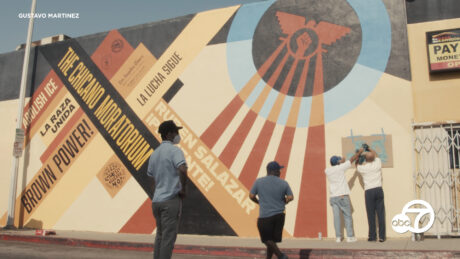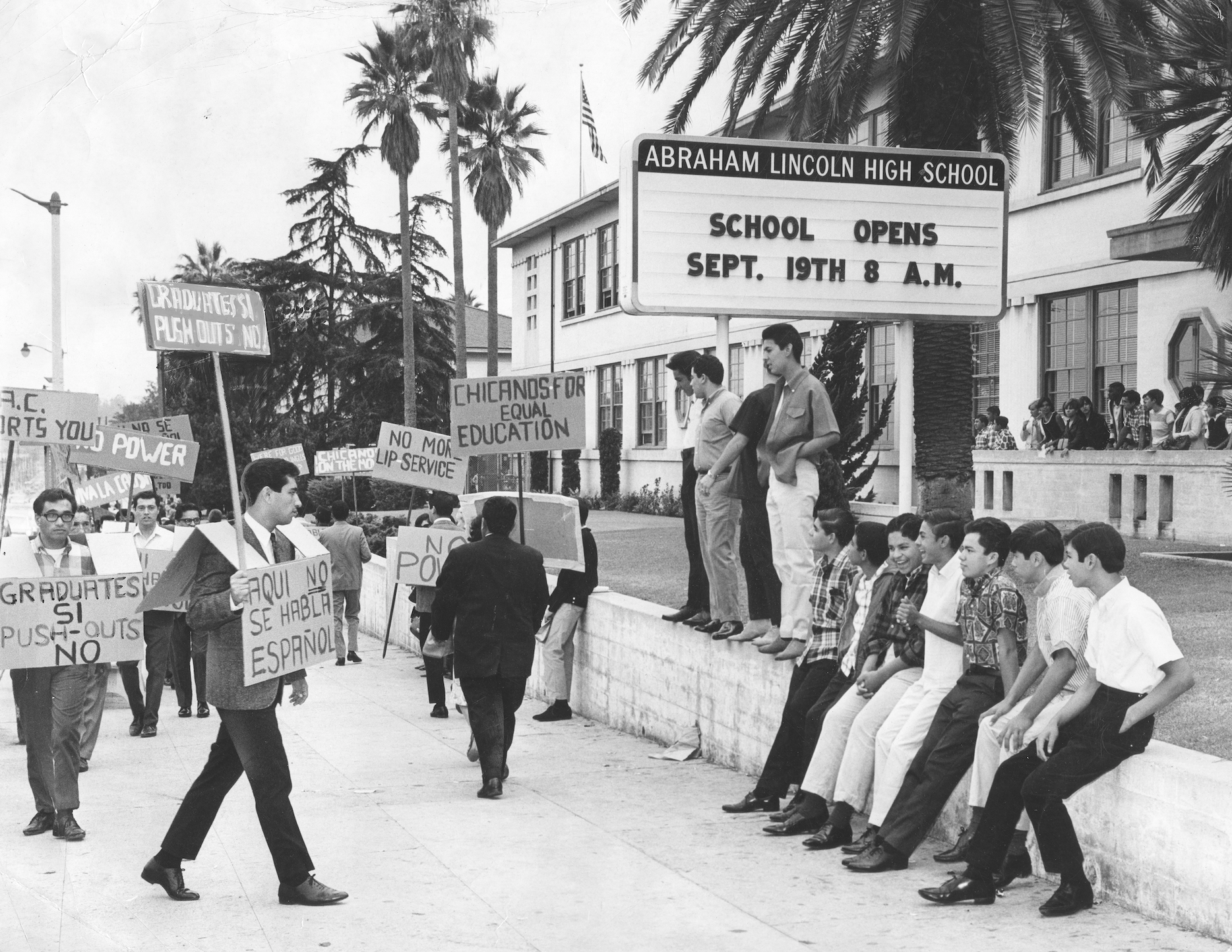The East LA Walkouts in May 1968, in which hundreds of students walked out of their classes to protest unequal conditions in the Los Angeles Unified School District, are considered the first mass protests of Mexican-Americans in the U.S. Photo courtesy of CSUDH Gerth Archives and Special Collections.
Editor’s note: This is one of the stories that ran in yesterday’s special e-edition of the Bulletin, a commemoration of the 50th anniversary of the Chicano Moratorium March.
By Robert Rios, Campus Editor
Only 15 miles separate California State University, Dominguez Hills and East Los Angeles, the most heavily populated Latinx neighborhood in LA County. But in late August, 1970, it was hard to imagine they were in the same country.
The previous semester, fewer than 2,000 students attended what was then known as California State College (although within four years that number would triple). Classes were split between two small clusters of buildings on either side of Victoria Street. Of the 86 members of its 1970 senior class, fewer than 20 were people of color, including two with Hispanic surnames.
As one student wrote in the 1970 yearbook,
“It was not uncommon to see to see cows grazing within a few hundred yards of the (buildings)…A little school stuck in the sticks, attended by less than 1,000 students and generally unheard of by many more.”
But college campuses across America were anything but silent.
Just three months before, in reaction to the news that President Richard Nixon had secretly expanded the Vietnam War by bombing Cambodia, students at 883 universities around the country staged a national strike, this campus one of them. Some held protests, such as Kent State in Ohio on May 4, where National Guard troops fired into groups of student anti-war protesters, killing four and wounding nine. Eleven days later, at Jackson State in Mississippi, city and state police opened fire, killing two and wounding 12.
Along with the anti-war protests, people of color were organizing, militantly, demanding changes to the systemic racism that kept so many locked in a cycle of poverty, their neighborhoods neglected, their aspirations stifled, their access to higher education denied.
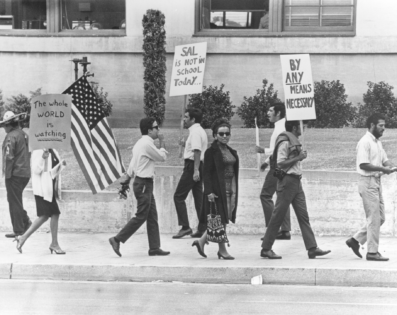
No group was organizing as swiftly, at least in Southern California, than Chicanos, the younger generation of Mexican Americans who rejected their elders’ attempts at assimilation into an Anglo culture that had so long ignored, repressed or scapegoated them. They embraced a language they were often forbidden to speak in school, championed the slogan “Viva La Raza! Chicano Powerl!” and questioned their inferior position in a country whose borders they had never crossed, but whose borders had crossed them
And the restless, seething epicenter of El Movimiento lay that 15 miles from this campus, in East Los Angeles, where concerns over the war and education would dovetail in the Chicano Moratorium March planned for Saturday, August 29.
How involved people who attended or worked at this campus is difficult to know, but there are traces. A glimpse of an iconic photo of one of our students marching alongside her husband, he dressed in a three-piece and she the wedding gown they were married in that morning; a sliver of recollection from one of the march’s chief organizers, of a professor from this school. And maybe others represented that fateful day.
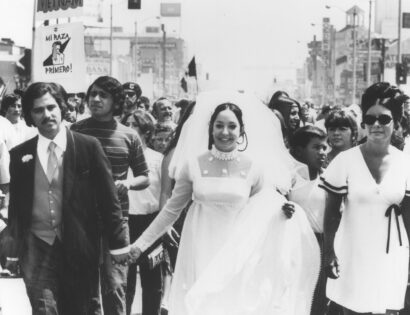
But though the extent of this university’s involvement in the march is shrouded in the fog of memory, this much seems certain: the echoes of that march and the movement behind it reverberate on this campus 50 years later. CSUDH’s journey to becoming a majority Latinx campus, about 65 percent, and the second-highest percentage of first-generation college students in the country has been shaped by the triumph and tragedy of that march. For even if, as some have speculated, the Chicano Moratorium March marked the beginning of the end of the dream of a Chicano movement as a potent, unifying political force, it was a monumental step in the long, uneasy and far from unresolved march toward a society of true equality and justice.
And this is its story
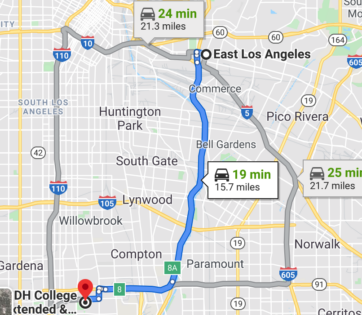
Prelude to the March
If you were young and Mexican. American in the U.S. around 1970, particularly if you lived in LA County, there was plenty to be pissed about. What few jobs there were paid low and were menial. You, or people who looked like you, were constantly terrorized by law enforcement. You were a second-class citizen in a land your family may have lived in far longer than those who held you in contempt. Your high schools were sick jokes, with high drop-out rates as high as 55 percent, a counselor to student ratio of 4,000 to 1, and class sizes averaging about 50.
And you were Grade A meat for the military war grinder. Don’t get a high school diploma, you can’t get a college deferment. Forget about a possible ticket to a career and better life through a college degree; you were looking at a ticket across the Pacific Ocean to fight a war against a people who had done far less to you than your countrymen.
And to top it all off, in 1966 the military lowered the test scores on its basic entrance exam, meaning that the lack of education that kept you out of college, actually helped you get in the military.
“If you couldn’t get an education, you couldn’t get a deferment,” Rosalio Munoz, one of the organizers of the Chicano Moratorium March said. “And jobs that were available were few and very low wage. And if you did find a job, the military paid more anyway.
“But there was also the prison system. Cops would go after the [Chicano youth. So there were so many in the courts and if you had a minor charge the judge would say, “?OK, I’ll [grant] probation if you sign up to go to war. It was all these inferiors conditions for us, we were second class citizens and that’s why so many were dying.”
The systemic failure of the Los Angeles Unified School District compelled legendary high school teacher Sal Castro to help organize the May, 1968 Blowouts, in which thousands of predominately Mexican American students, without the aid of Tik Tok, Twitter or YouTube, walked out of classes in 13, mostly Eastside high schools.
That infuriated law enforcement even more. Student leaders were arrested. Activist groups were infiltrated and spied upon. Police harassment, beat downs and even deaths increased.
But El Moviemento had arrived in the barrio. And a Los Angeles Times columnist and KMEX-TV reporter named Ruben Salazar began writing about it.
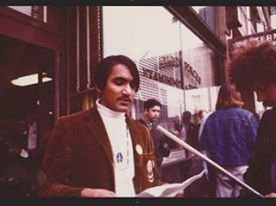
Munoz, a product of the barrio, was also the first Mexican American student body in UCLA history. He stayed in school to finish out his term as president, and graduated in Spring, 1969. A few weeks later, he received his draft induction notice. The date: Sept. 16, 1969.
Although he’d entered UCLA in 1964 as more of an athlete and history lover, he’d evolved into an activist, and he was determined to use what notoriety he had in the Chicano community as a former UCLA student president to get it more involvedin the anti-war campaign.
So on the day he was first supposed to show up in front of the draft board, he called the local papers and TV stations and turned the occasion into a made-for-TV event.
“It gave me an opportunity to become a bigger spokesperson against the war,” he said. “if I take on that role of getting more people to protest the war and maybe some more people to refuse to go, or not to volunteer, and talk to schools, students, and leaders against the war, it would get other people to do that.”
There had been anti-war expressions against the war in the East LA Chicano community since 1967, but “what really ignited the Chicano antiwar movement involved those early Chicano protesters who refused induction into the military,” Raul Ru Ruiz, an editor of LA Raza, one of the many Chicano newspapers in East Los Angeles at the time, told Mario Garcia in his 2015 book, “The Chicano Generation Testimonios of the Movement”(available online at the CSUDH library) “His refusal to be inducted was orchestrated to bring attention to the fact that Chicanos were being heavily exploited by the war effort.”
Munoz traveled the state, speaking at rallies and conferences, and when he heard in the summer of 1970 that a commitee was being formed to set a date for a Chicano march in East LA, he knew he had to be involved.
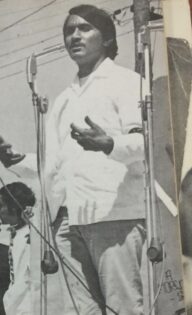
“Our front line [should have been] in our struggle for social justice in the barrio, not Vietnam,” Munoz said. Along with the disproportionate number of Mexican Americans being drafted and dying in Vietnam (one study at the time reported that in the states with the greatest Mexican American population, including California, they represented about 13 percent of the total population but 20 percent of the deaths) there was the economic impact, Munoz said.
“That money could have been used to create more jobs, to have better healthcare, to improve education, to make smaller classrooms,” he said. “
The March
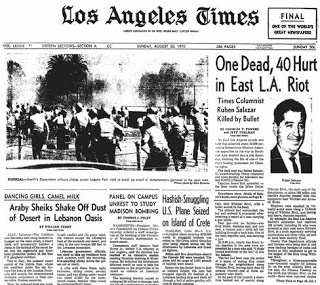
The three-mile, Aug. 29 procession down Whittier Boulevard began at Belvedere Park and ended at Laguna Park.. The mood was celebratory and inclusive, with Black, brown, white and Asian faces, young people, families with children, and older people joining in a peaceful march intended to show the unity and strength of a movement that many outside it still misunderstood.
“It was like a day in the park,” Ruiz said.” There was music, and people were having a good time..All told, I later estimated about twenty thousand protesters, mostly Chicanos. It was not only the largest demonstration during the movement but also one of the largest assemblies of Chicanos in history.”
Gloria Arellanes, a local activist who worked with the Brown Berets, the organization that first formed the committee, recalled in Garcia’s book that:
“It was an incredible sight. People were yelling antiwar and Chicano movement slogans and cries. It was really very upbeat. People were happy. Whole families participated. As we moved onto Whittier Boulevard, the main artery of the march, I saw people coming out of stores and expressing support. I remember in particular some ladies coming out of a hairdresser shop and waving to us, even giving us the power sign! The whole atmosphere was very celebratory and exciting. As we went farther, I began to see just a mass of people, many carrying banners and signs, some of which indicated the group or places they represented.”
” I don’t know if Dominguez had a sign there, maybe they did, but there were Dominguez Hills students there, some that had graduated from there,” Munoz said. “But, yes, they were there.”
“Mariachi to Mayhem”
Munoz was the first speaker at the rally after the approximately 90-minute march ended at Laguna Park. As he finished his remarks, the scene turned from one what participant said “mariachi to mayhem” in a heartbeat.
Arellanes, who was standing by the stage as security for the Brown Berets, recalled:
“{I had] positioned myself next to the stage as part of the security so I could look at the large crowd. It wasn’t long before the sheriff s attacked. I almost immediately went into like a trauma seeing what was happening. All I could make out toward the back of the park was a wave that began to move people out. This is when I started seeing the attack. Some were still entering the park.
” I really think I went into shock and later suffered post–traumatic stress syndrome. Everything was so happy and good, and then I’m going, “What happened?” I saw people running all over the place and screaming. I saw children and abuelitas (grandmothers) trying to escape the sheriffs . It was just very, very traumatic to see all this. It was horrible.
Accounts differ, but basically a cadre of LA Sheriff deputies stormed the park, claiming that it needing to be cleared to dispel troublemakers who had caused a scene at a liquor store on the route.
Most of the participants fled, but some stayed and fought with the officers. Things escalated, protesters accused the cops of starting everything, the cops blamed the protesters and after nearly five hours of combat, smashed store windows up and down Whittier Boulevard, and more than 150 arrests three people were dead, including someone who was there to chronicle it, Ruben Salazar.
Salazar was found dead in the Silver Dollar Cafe, 22 blocks from Laguna Park, where he’d stopped in for a break while covering the March.The official cause of death: a tear gas canister to the side of his head, shot by a LA County Sheriff’s deputy through the open door of the bar, who claimed to have been responding to a report of an armed man in the bar.
But 50 years later, there are still some who dispute that.
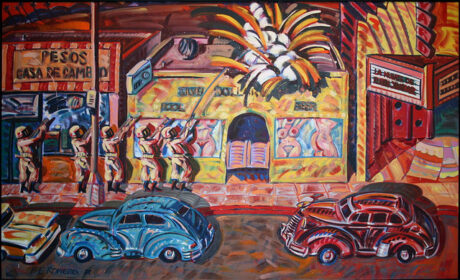
The Aftermath
There would be two more marches after the August, 1970 one, both ending in violence. But plagued by in-fighting, a backlash from Mexican American community leaders, police informants and the lingering devastation over Salazar’s death and how quickly a peaceful march ended in chaos, by 1971 any sense of coordinated organizing in the East LA movement had vanished. And with it, El Moviemento
The two main concerns of the Aug. 29 march, the Vietnam War and educational inequities, took different trajectories. The war raged for two years until, shortly before the November, 1972 election, the U.S. and North Vietnam reached a peace settlement.
It took longer to improve education for Mexican Americans, at least in hard numbers. The nationwide status dropout rate for all Hispanics fluctuated, but 20 years later was nearly the same, around 34 percent as 1970, Not until 2000 did it begin steadily declining, and even at 9.5 percent in 2017, it was still double that of whites.
But if one considers education as much process as much as results, there is one enormous impact wielded by the movement and march.
“Ethnic studies,” Dr. Vivian Price, a CSUDH professor in interdisciplinary studies, said. “We just signed AB 1460 [which will now require all CSU students to take a class focusing on either Black, Hispanic, Asian or Native American studies.
Price said AB 1460 is a culmination, or direct line, of the demands of groups like Chicanos in the late 1960s to not be relegated to the margins, to stand up and say, “yes, we matter.”
Higher high school graduation rates translate into more college students, and CSUDH has seen tremendous growth since more Hispanics have successfully navigated high school. In 2000, Hispanics comprised 27 percent of the campus population, 2 percent higher than Black students. It inched up that decade, but in 2010 there was an explosion, with 40 percent of the population Hispanic, and by 2017, it had topped 60 percent.
Additionally, the way the Latinx population responded to the punitive threats of Proposition 187 in 1994 and, more recently, DACA, shows that it has “developed more,” Munoz said. “People [are] more motivated[and have] a greater appreciation of what we could achieve with unity and focus.”
But it’s hard to dispute that the idealism so many in the movement shared ended that hot summer day in 1970
“Organizing the massive demonstration of Mexican Americans’ opposition to the Vietnam War was a huge achievement for the Chicano movement,” MArio Garcia, a professor at UC Santa Barbara, told the Los Angeles Times Aug. 23. “But it turned into a riot, which had the ironic effect of tagging the movement as violent even though deputies had caused most of the trouble.”
“The Chicano movement,” he added, “never fully recovered.”
But, Munoz said, it never fully died either.
“If we fight, eventually we win. If we don’t fight, ain’t no progress.”
–Rosalio Munoz
“I’m still a Chicano,” he said. “I’ve got a lot of friends that are still here in politics, in law, with children, with activities to help the community and still working to build a community. It didn’t disappear, the idealism is not gone. It was transferred to help your kids, help your grandkids and others in your family or people that are going to your school.”
What also remains, Munoz said, is an example of a people long marginalized and scapegoated, who finally decided to claim their own identity defined by their own terms. And that progress takes work.
“They wanted us to go away, they acted as if we went away or we stopped fighting. Who’s gonna really stop fighting when they treat you wrong continuously? You can’t put up with it. If you have any kind of self-pride, you have to stand up, you have to help other people that have been knocked down and pick them up….but the other thing is we also know from a lot of experience, never give up. If we fight, eventually we win. If we don’t fight, ain’t no progress.”
